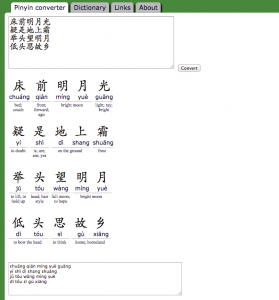Using tones to distinguish lexical and grammatical meaning is not always an easy task for native speakers of non-tonal languages. When I taught Chinese many years ago, the tones were the biggest headache for my students. As adults, my students were good at learning vocabulary and grammar (adults learn these differently from children who acquire Chinese as their first language, but that’s a whole different topic), but almost all of them struggled more or less with the tones. At the time, I had always wished there was a tool that could show the students the Pinyin of the characters and pronounce it for them, so that my students could get help whenever they practice. Unfortunately, I wasn’t able to find anything at the time, but such tools exist now and are available at Reed.
Here is the scenario: you came across a character/phrase (either you know or you don’t) and you are not sure how to pronounce it. This is what you can do:
Go to the Pinyin Converter, copy and paste the character(s) you want to learn into the box, and click “convert.” You will find the Pinyin for each character, as well as the meaning(s) for each character/phrase.
Then, you find the Pinyin of the character you’d like to learn into Mandarin Chinese Pinyin Chart with Audio. If it’s a phrase, you will need to do it one character at a time.
Pick the tone and listen.
And you are done! It takes some practice to be able to hear the differences in different tones but it will happen.
Besides these two tools that you can use jointly, you can also come to the Language Lab and use Clavis Sinica, a Chinese reading and reference software. You can find it in the language application folder on the desktop on all of the Language Lab machines. The recording feature in Mango Languages (please register using your Reed email) is also great–you can listen to the native speaker, record your own version (our headsets in the lab will allow you to hear yourself as you are recording), and then compare your speaking with the native speaker’s recorded version with both sounds and the sound wave visualization.



